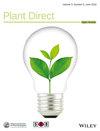A K homology (KH) domain protein identified by a forward genetic screen affects bundle sheath anatomy in Arabidopsis thaliana
IF 2.3
3区 生物学
Q2 PLANT SCIENCES
引用次数: 0
Abstract
Because of their photosynthetic capacity, leaves function as solar panels providing the basis for the growth of the entire plant. Although the molecular mechanisms of leaf development have been well studied in model dicot and monocot species, a lot of information is still needed about the interplay of the genes that regulate cell division and differentiation and thereby affect the photosynthetic performance of the leaf. We were specifically interested in understanding the differentiation of mesophyll and bundle sheath cells in通过正向遗传筛选确定的 K 同源(KH)结构域蛋白会影响拟南芥的束鞘解剖结构
由于叶片具有光合作用能力,因此叶片就像太阳能电池板一样,为整个植物的生长提供了基础。虽然在双子叶和单子叶植物中对叶片发育的分子机制进行了深入研究,但对于调控细胞分裂和分化并进而影响叶片光合作用性能的基因之间的相互作用,仍有许多信息需要了解。我们特别想了解拟南芥叶肉细胞和束鞘细胞的分化过程,目的是找出参与决定束鞘解剖结构的基因。为此,我们利用甲基磺酸乙酯(EMS)诱变表达叶绿体靶向绿色荧光蛋白(sGFP)的报告基因系,并在束鞘特异性启动子的控制下建立了正向遗传筛选。根据 GFP 荧光表型,产生了许多突变体,并通过测序映射方法确定了含有突变候选基因的基因组片段。其中一个具有增强 GFP 荧光表型的品系(命名为 ELEVATED BUNDLE SHEATH CELLS SIGNAL 1 [ebss1])被选中作进一步研究,并通过基于 CRISPR/Cas9 诱变位于映射基因组片段的候选基因来验证责任基因。经过验证的基因 At2g25970 编码一个含 K 同源(KH)结构域的蛋白质。
本文章由计算机程序翻译,如有差异,请以英文原文为准。
求助全文
约1分钟内获得全文
求助全文
来源期刊

Plant Direct
Environmental Science-Ecology
CiteScore
5.00
自引率
3.30%
发文量
101
审稿时长
14 weeks
期刊介绍:
Plant Direct is a monthly, sound science journal for the plant sciences that gives prompt and equal consideration to papers reporting work dealing with a variety of subjects. Topics include but are not limited to genetics, biochemistry, development, cell biology, biotic stress, abiotic stress, genomics, phenomics, bioinformatics, physiology, molecular biology, and evolution. A collaborative journal launched by the American Society of Plant Biologists, the Society for Experimental Biology and Wiley, Plant Direct publishes papers submitted directly to the journal as well as those referred from a select group of the societies’ journals.
 求助内容:
求助内容: 应助结果提醒方式:
应助结果提醒方式:


